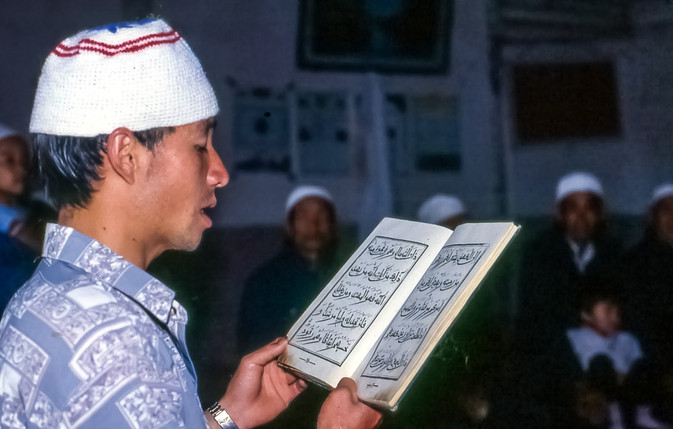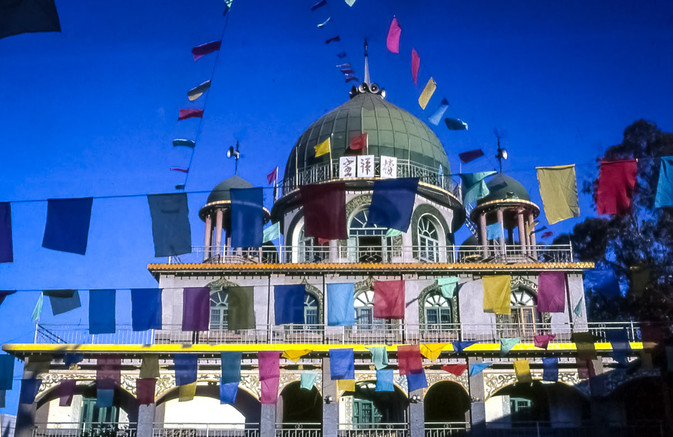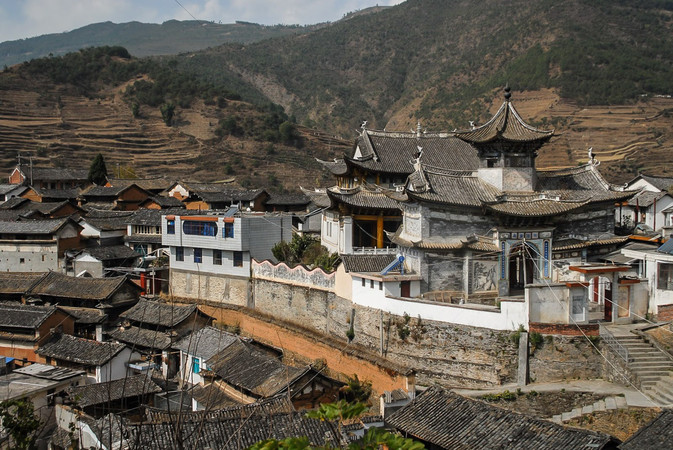

Of all of China's 56 minority nationalities, the only one that qualified for such designation by religion alone, rather than language or ethnic identification, were the Hui, who are Muslim, but ethnically Hui Chinese. Some of them are descendants of the first converts from coastal ports visited by Muslim Arab traders in the seventh and eighth centuries.
From there they eventually spread further inland, but the main components of what would become a separate Hui identity were Muslim warriors who were part of the Mongol forces that conquered China in the thirteenth century, stayed in the country, intermarried with local women and, except for retaining their religion, adopted Chinese customs and lifestyles.
Yunnan's Hui today number around 700,000, making them the seventh largest minority in the province. Some can trace their ancestry back a thousand years or so. But the presence of Muslims in Yunnan vastly increased with the arrival of Kublai Khan's invading armies in 1253. The Mongol forces that vanquished the Kingdom of Dali and overran all of present-day Yunnan included many brigades of Muslim soldiers from Central Asia, who later were the dominant constituents of the garrisons established at Dali (大理) and Weishan (巍山).
Kublai Khan annexed Yunnan to the Mongol Empire and appointed Sayid Ajjal, a Muslim from Bukhara, as governor. Reflecting the Khan's appreciation of Chinese civilization, Governor Sayid Ajjal ordered the construction of not only mosques, but also Buddhist and Confucian temples in Kunming. He was also a staunch promoter of Confucian education. His successors followed the same policies and by the end of the Yuan dynasty, Kunming and other cities had a substantial number of Muslim residents.
When Ming dynasty armies rolled into Yunnan to expel the Yuan forces, the Mongol units left, but their Muslim allies mostly dissolved into the local population. Largely sinicized by then, the Hui became a permanent part of Yunnan's ethnic tapestry. One of their number, Zheng He (郑和) from Jinning (晋宁), rose to become the commander of several naval expeditions in the early fifteenth century, and sailed as far as the African coast.
Throughout the Ming and most of the Qing dynasties, the Hui were a fully integrated part of Yunnan society. In places where they were numerous, such as around Dali and Weishan,Xundian (寻甸) and Tonghai (通海), they were farmers like all of their neighbors. In the cities they were involved in commerce, ran shops and organized long-distance caravans. With the nineteenth century industrial development of the province, they also became involved in mining. But it was a mining dispute in Shiyang (石羊), in Chuxiong Prefecture (楚雄州), that sparked disaster for the Hui people of Yunnan.
Both Han and Hui operated silver mines in Shiyang, but the Han mines were running out of deposits. When the Hui refused to give the Han employment in their own mines, the Han attacked them, but were driven back to Kunming. Mandarins in the city pacified the Hui there with promises, but meanwhile a coterie plotted to exterminate the province's Muslims.
Massacres commenced throughout the northern half of the province on May 19, 1858. Strong Hui communities around Huilong in the east and Dali in the west organized armed resistance and thus the province plunged into the turbulent years of the so-called Muslim Revolt — orPanthay Rebellion, after another name for Yunnan's Hui. "Muslim Revolt" is somewhat misleading, however, because after a two-year stalemate in the east, Hui leaders made a deal with the Yunnan government and were given command of a mixed Han-Hui army charged with putting down the rebellion in the west, where the Hui had the support of the Bai, Yi and other minorities.
At the outbreak of the massacres, the Hui around Dali — where they were one-third of the population — held off Han attackers trying to reach the city in a seesaw battle that changed dramatically with the arrival of Hui reinforcements led by Du Wenxiu. After routing Han forces,Du Wenxiu (杜文秀) occupied Dali, declared it the capital of a new state — the Peaceful Southern Kingdom — and installed himself as ruler with the name of Sultan Suleiman. He set up an efficient administration, promoted commerce, won the support of most ethnic minorities in the west and southwest and repulsed two attacks by government armies.
The new state consolidated control over western Yunnan while the Qing government was still preoccupied suppressing the much more devastating Taiping Rebellion in southeast China. That was accomplished in 1864, but another revolt broke out among the minorities in northeast Yunnan. Only in 1867 was the provincial government ready to dispatch a large Han-Hui army against Dali. But that contingent suffered a crushing defeat. Du's army pursued the remnants all the way to the walls of Kunming and settled in for a siege.
This was the high-water mark of the Revolt. But Du's forces could neither breach Kunming's walls nor completely blockade roads into the city. After several months of trying, Du Wenxiu withdrew his forces back to Dali. The following year the Qing government started subsidizing arms purchases for a new provincial army. Under General Yang Yuke, the freshly strengthened force captured Ning'er and its salt mines, depriving Dali of its principal source of revenue.
From Ning'er, the Qing army began its slow but relentless drive north to Dali, finally reaching the city gates before the end of 1872. Du Wenxiu surrendered the following January and committed suicide. The victors decapitated the corpse — which was later buried in Du's nearby home village of Xiadui — mounted the head on the ramparts and spent another year mopping up the last of the resistance.
Following this, Qing troops embarked on a horrific revenge campaign, slaughtering any Muslims they could capture. Thousands fled to northern Burma and northern Thailand, where they eventually got into the caravan trade. At the Dieshuihe Waterfall (叠水河瀑布) in Tengchong(腾冲) — along a powerful cataract of the Daying River (大盈河), Qing soldiers hurled hundreds of local Muslims over the precipice to their deaths. In Dali, the Hui were forbidden to live in the city and pursued throughout the plain. As many as could fled as the government confiscated their lands and parceled it out to the Bai minority.
Government revenge did not extend to the minority populations that had supported Du Wenxiu. Around Dali, the Bai people helped hide their Hui neighbors. Other Hui adopted the Bai language for everyday use and concealed evidence of their Islamic identity. Once the heat was off they could be more open about their religious affiliation, but often retained use of the Bai language. And when the Hui returned after it was safe to do so, the Bai who had benefitted from the land confiscation returned that land to the Hui and helped them rebuild their homes and mosques.
Mosque and Hui quarter in Yangbi
Famine followed the end of the rebellion, as well as a total breakdown in commerce that lasted for several years. Twenty years after the outbreak of hostilities, Yunnan's population had declined from eight million to three million. The province recovered, as did the Hui, resuming their customary roles in Yunnan, taking up familiar trades, tending their farms and getting back into long-distance trade by caravan. A century later, Islam and the Hui identity came under attack during the Cultural Revolution, but so did the traditions of everybody else — including the Han. Mosques were closed or turned over to other uses, as mosques, churches, temples and monasteries across the entire country suffered the same fate.
With the launch of the Reform Era, Hui culture experienced the same ethnic revivalism that swept Yunnan in the 80s and 90s. Mosques reopened, drew large crowds for Friday services and imams ran new Islamic studies centers that taught Arabic. The Hui also established links with overseas Muslims, especially in the Middle East, who often sponsored the construction of new mosques, in the Arabian style.

new mosque in Wenming, Eshan County
Externally, the original Yunnan mosques resembled Buddhist temples in shape and design. The crescent moon mounted in the center on the top of the roof was one obvious difference, as was the lack of any depiction of humans or animals in carved embellishments. Interiors were simple, with a niche in one wall identifying the direction of Mecca. Many mosques in the indigenous style are still in use in Hui towns and villages throughout the province. Some are larger, more complex and impressive compounds, sited on hills above town, such as at Yangbi (漾濞), south of Dali, and Gonglang, in Nanjian County (南涧县).
Other Hui communities have replaced their antique mosques with new ones built in Middle Eastern styles, featuring gleaming white walls, green or blue onion-shaped domes, towering minarets and capacious interiors. These are altogether more imposing than the simple structures they replaced. They are bigger and taller than the originals, like the splendid, three-story mosque at Wenming Village (文明村) and the new ones in the heart of Kunming.
Sizable Hui communities live in the northern, eastern and western parts of the province. Xundian, north of Kunming, and Weishan, in Dali Prefecture, are Hui and Yi Autonomous Counties and nearly every city in Yunnan has a Hui neighborhood. Kunming once had a rather large one, mostly in the area between Jinbilu and Dongfeng Xi Lu. When Yunnan opened its doors to foreigners this became part of the tourist itinerary, less for its classic mosques than for the sight of huge slabs of beef hanging from racks all along Shuncheng Lu.

Classic Yunnan-style mosque at Gonglang, Nanjian County
Some Hui-inhabited places qualify as tourist attractions just because of their beautiful settings. Najiaying (纳家营), with a new mosque dominating the northern end of the village and an old one in the southern market area, lies beside Qilu Lake (杞麓湖). Wulizhou (五里州), on the lower slopes of Cangshan (苍山) with a good view of Erhai Lake (洱海), straddles a stream coming down from the mountains near Dali. The Hui quarter of Yangbi, the only part of the old city still extant, lies along a road below the classic mosque that leads to a historic bridge on theTea Horse Road.
The caravans across Yunnan have disappeared, but the Hui in that business graduated into the modern transportation system. Urban Hui make up a large proportion of the city taxi drivers and are the people who drive the inter-city buses, vans and trucks. They kind of announce their identity by posting a decal in the corner of the windshield displaying a verse from the Koran in Arabic.
Other urban Hui find employment in the restaurant business. Han Chinese generally like to eat pork, but they also appreciate a good meal of beef now and then and first choice is always a Hui restaurant. Perhaps the enduring popularity of Hui restaurants, plus the Hui role in transportation, helps maintain the community's image of a normal, fully integrated part of Yunnan's socio-economic society. Hui leaders in China have been at pains to affirm their loyalty to the state and disassociate themselves from any covert sympathy with co-religionists espousing separatism or extremism.
The Hui in Yunnan are certainly devout, but not at all fundamentalist, radical or even very strict. The women may wear headscarves, but do not dress in the burka associated with extremely conservative Muslims. The men don white skullcaps for Friday prayers, but may not wear it other days. Theirs is not an exclusive society wary of outsiders. As a non-Muslim foreigner, in my own encounters with the Hui, explaining my visit as a desire to learn about one of Yunnan's minorities, I was always warmly welcomed, invited to observe Friday prayers, encouraged to photograph and never pressed to join the services.
It was the same experience I had calling on other minorities. Buddhists never insisted I bow before any image. Christians didn't ask me to join in the singing of hymns. Animists never requested I leave an offering at a spirit altar. Everyone was pleased just because I was interested in them, and told or showed me everything I wanted to know. The Hui are no different, just another friendly minority in the ethnic mélange of Yunnan, where harmony and mutual respect are the old and new normal.
You will only receive emails that you permitted upon submission and your email address will never be shared with any third parties without your express permission.
